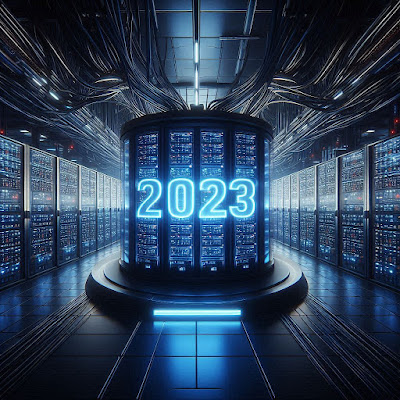2023 was a landmark year for AI, characterized by groundbreaking advancements in large language models, multimodal AI, text-to-video generation, and AI speech synthesis. The year witnessed a remarkable acceleration in AI capabilities, with innovative applications permeating mainstream products and services. This rapid progress sparked both excitement and concerns about the technology's societal impact, marking a pivotal moment in the evolution of artificial intelligence.
December
- Mistral releases Mixtral 8x7B
- Mixture-of-experts model with 47B parameters
- Demonstrates efficiency and strong performance
- Suno AI introduces its state-of-the-art audio generation model
- Specializes in creating high-quality, natural-sounding audio from text
- Finds applications in entertainment, accessibility, and content creation
- Google integrates Gemini into Bard
- Significantly enhances Bard's functionality with multimodal capabilities
- Improves Bard's reasoning, understanding, and generation abilities
- Google announces Gemini
- Next-generation large language model, successor to LaMDA and PaLM 2
- Multimodal AI model capable of understanding and processing text, images, audio, and video
- Released in three sizes: Ultra, Pro, and Nano, for different use cases
November
- OpenAI introduces GPT-4 Turbo with 128k context window
- Extended context allows for processing of much longer documents
- Anthropic releases Claude 2.1
- Improves performance on coding, math, and reasoning tasks
October
- OpenAI integrates DALL·E 3 into ChatGPT
- Available for ChatGPT Plus and Enterprise users
- Enhanced image generation capabilities within the chat interface
September
- Microsoft integrates GPT-4 into Bing and rebrands it as Copilot
- Offers AI-powered search and digital assistance across Microsoft's ecosystem
August
- OpenAI releases Sora with limited access, a state-of-the-art text-to-video model
- Showcases unparalleled video generation capabilities from textual prompts
- Enhances the creative possibilities for filmmakers, advertisers, and digital artists
July
- Meta releases LLaMA 2
- 70B parameter open-source language model
- Marks a significant contribution to open-source AI development
May
- IBM announces Watsonx platform and Granite language models
- Watsonx: AI and data platform for enterprises
- Granite: Family of foundation models, including a 70B parameter model
- Focused on enterprise-grade AI solutions and responsible AI development
- Google introduces PaLM 2, a 340 billion parameter model trained on 3.6 trillion tokens
- Successor to PaLM, with improved multilingual, reasoning, and coding capabilities
- ElevenLabs launches its next-generation AI speech synthesis
- Offers remarkably natural and expressive voice generation
- Widely adopted in audiobooks, virtual assistants, and multimedia projects for its high-fidelity speech quality
April
- Mistral AI is founded
- French AI company started by former employees of Meta and Google DeepMind
March
- OpenAI releases GPT-4
- Multimodal model capable of processing both text and image inputs
- Set new benchmarks in AI performance and capabilities
- Runway introduces Gen-2, an advanced text-to-video model
- Capable of generating high-quality video from textual descriptions.
- Pushed the boundaries of creative AI, finding applications in content creation and media production.
- Anthropic releases Claude
- AI chatbot focuses on safety and ethical considerations
February
- Google releases Bard
- AI chatbot powered by the LaMDA language model
- Perplexity AI launches its eponymous search engine
- Combined large language models with real-time web information
- Offers conversational search experiences
